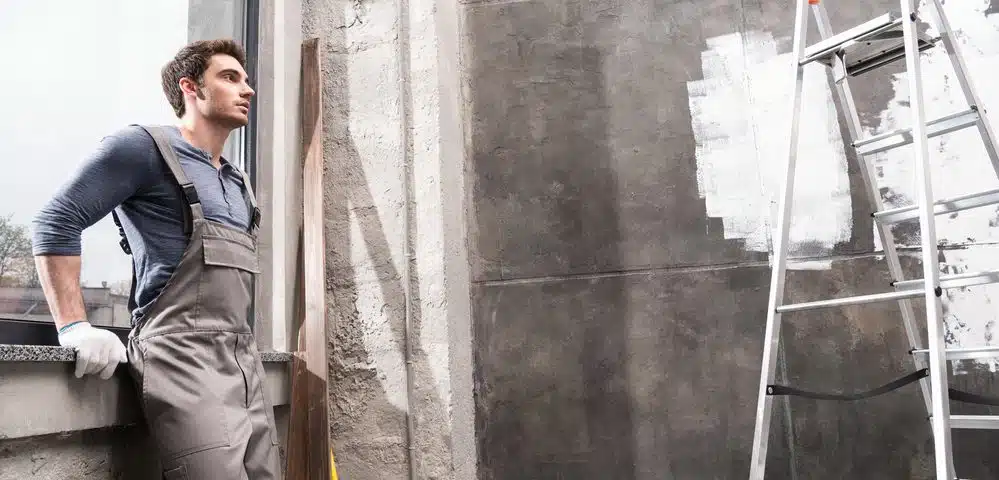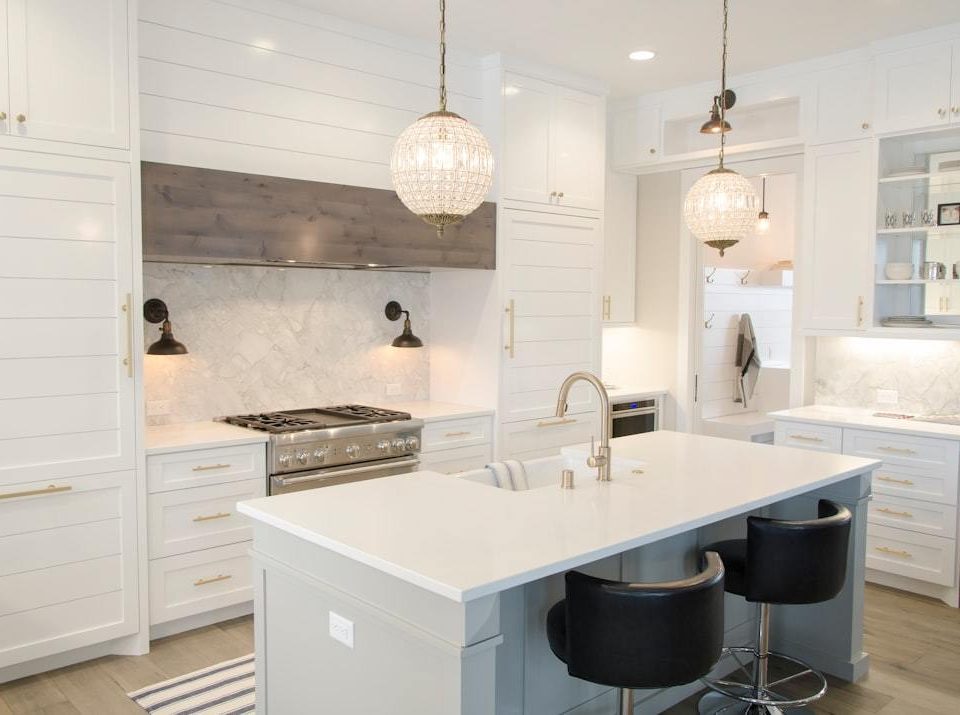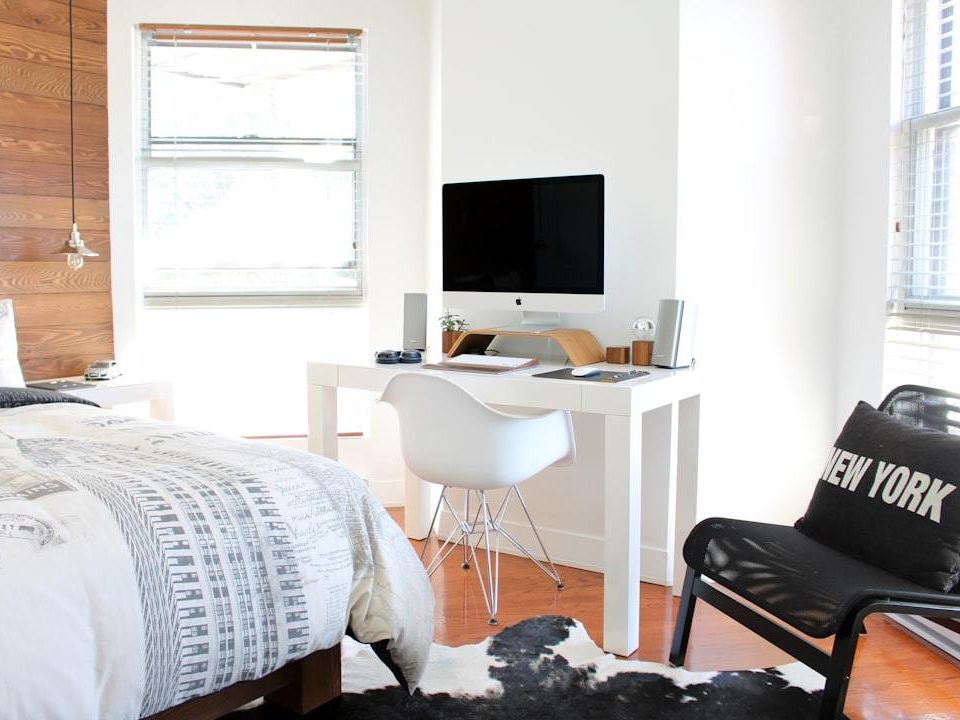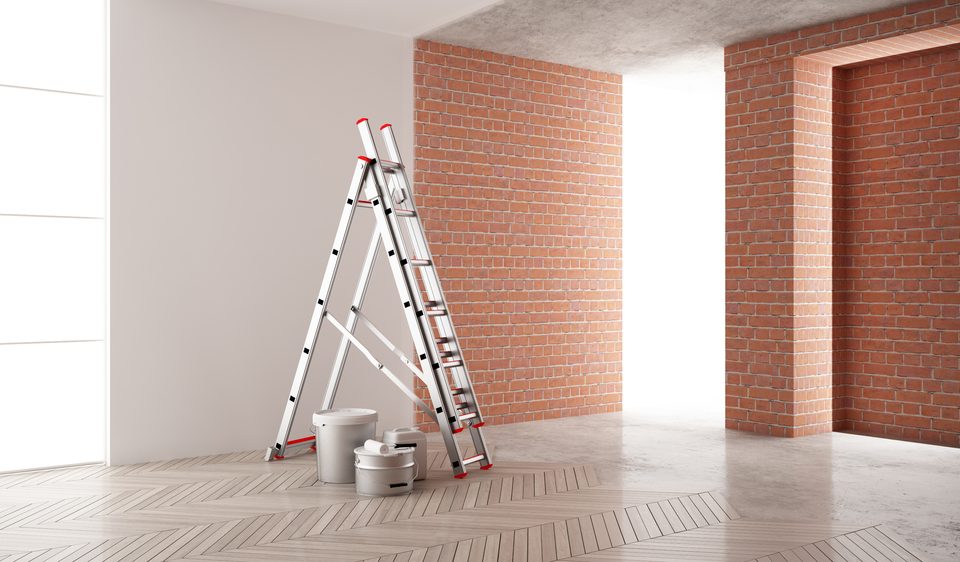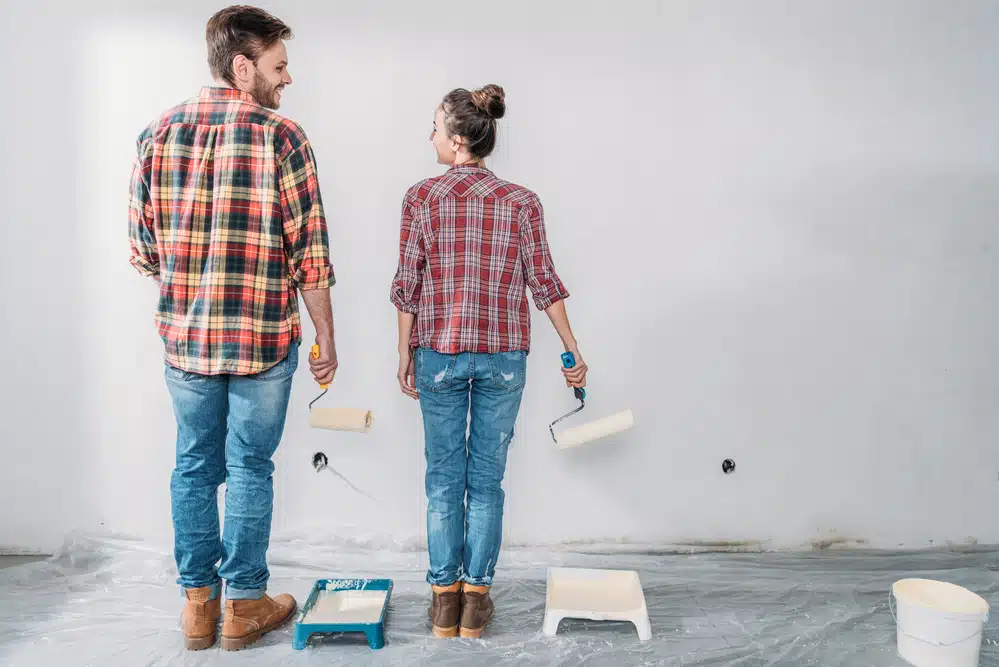
What Color Should I Paint My House Outside: A Guide
May 9, 2023
Can You Paint Exterior House in Winter? Tips & Techniques
June 19, 2023When posed with the query, “Do I paint my house myself?” one must take into account numerous elements before making a conclusion. Before embarking on the project of painting your home, it is important to evaluate if you possess the necessary expertise and experience. In this blog post, we will explore various aspects of tackling a paint job on your own.
We’ll begin by assessing your painting skills and determining if you have the necessary experience for such a project. Next, we’ll delve into the importance of considering time and cost when deciding whether to take on this task yourself or hire professional painters. Furthermore, we’ll discuss how to properly prepare the room for painting, as well as select quality paint that will ensure long-lasting results.
As you continue reading about whether you should paint your house yourself or not, you will learn valuable tips on applying even coats of paint for a flawless finish and effectively cleaning up after completing the job. Lastly, we’ll provide guidance on inspecting your work in order to achieve satisfaction with the final outcome.
Table of Contents:
- Assess Your Painting Skills
- Consider Time and Cost
- Prepare the Room
- Select Quality Paint
- Apply Even Coats
- Clean Up After Yourself
- Inspect Your Work
- Is it a Good Idea to Paint My House Myself?
- Can I Paint My Whole House Myself?
- Is It Cheaper to Paint Your House Yourself?
- Does Painting the Exterior of Your House Increase Value?
- Conclusion
1. Assess Your Painting Skills
Before deciding to paint your house yourself, it’s essential to understand the level of painting skills you possess. Painting a house is not merely about putting color on walls; it necessitates proper preparation, technique, and attention to detail for an excellent outcome. If you’re not confident in your abilities or lack experience, hiring professional painters from Matt The Painter might be the best option for achieving an exceptional finish.
A. Determine Your Skill Level
To assess your painting skills accurately, consider any previous painting projects you’ve completed and how satisfied you were with the results. Were there any issues, such as uneven coats or visible brush strokes? Evaluating the time it took to complete past painting projects can help determine if DIY house painting is suitable for you. Reflecting on past experiences can help determine if DIY house painting is suitable for you.
B. Research Techniques and Best Practices
Before beginning the project, it is advisable to become familiar with painting techniques and best practices. There are numerous resources available online that offer step-by-step guides and video tutorials on topics like cutting edges, rolling walls evenly without lap marks, and proper surface preparation (source). Beforehand preparation is essential to ensure a successful outcome.
C. Practice Makes Perfect
- Test Paint Samples: Before committing to a color or brand of exterior paint for your entire house, test samples on small areas first (such as inside closets) so that you can see how they look under different lighting conditions throughout the day.
- Hone Your Technique: Practice your painting technique on a spare piece of drywall or plywood to get comfortable with the process and refine your skills.
- Seek Feedback: Ask friends or family members for feedback on your practice work, as they may notice areas that need improvement that you might have overlooked.
In conclusion, assessing your painting skills is crucial before deciding to paint your house yourself. Should you feel assured in your abilities and are ready to commit effort into researching and rehearsing, painting one’s own house can be a satisfying undertaking. However, if you lack confidence or experience, hiring professional painters from Matt The Painter will ensure an exceptional paint job without the stress of doing it yourself.
Assessing your painting skills is essential before deciding whether to paint your house yourself or hire a professional. Weighing up the expenditure and amount of effort necessary to finish the task should be taken into account when determining what route to take.
2. Consider Time and Cost
Weighing the expenditure and effort involved in painting a house against hiring a pro is an essential step before taking on this project. Painting a house can be quite laborious, particularly if you lack experience or don’t have much free time available.
On average, painting one room takes about 4-6 hours for preparation and actual painting work. However, this estimate doesn’t include drying times between coats or additional touch-ups that may be needed later on. Keep in mind that larger rooms or more complex surfaces will require even more time.
In addition to the amount of time required for the job, consider the costs involved in purchasing all necessary supplies, such as:
- Paint
- Primer (if needed)
- Brushes and rollers
- Tape for masking off areas not being painted
- Coverings for furniture and floors
If you don’t already own these items, they can add up quickly – potentially making DIY painting less cost-effective than initially anticipated.
Hiring a professional painter like Matt The Painter might seem like an expensive option upfront; however, the benefits often outweigh the costs. Professional painters are experienced at completing projects efficiently while maintaining high-quality results. Additionally, professionals come equipped with their tools and materials – eliminating any extra expenses on your end.
In conclusion, when considering whether to paint your house yourself or hire a professional painter like Matt The Painter, weigh the pros and cons of each option. DIY painting can be rewarding if you have the skills, time, and resources available. However, hiring a professional ensures high-quality results without the added stress of managing the project on your own. Ultimately, the choice depends on your individual needs and preferences.
Considering time and cost can be a major factor when deciding to paint your house yourself. For a successful painting job, proper prep is key in order to get the desired outcome. Now let’s look at how we can prepare the room for painting.
3. Prepare the Room
Before you begin painting your house, it’s essential to properly prepare the room for a smooth and efficient process. This involves gathering all necessary supplies, covering furniture and floors, and ensuring that surfaces are clean and ready for paint application.
Gather Supplies
Gather the required items for your painting project by collecting all of the essential materials and equipment. These may include:
- Paintbrushes (different sizes)
- Rollers (with extension poles if needed)
- Paint trays or buckets
- Ladders or scaffolding (for high walls or ceilings)
- Tape measure
- Painter’s tape
- Drop cloths or plastic sheeting
Protect Furniture & Floors
It’s crucial to protect your furniture, flooring, fixtures, and other belongings from potential paint splatters before starting any painting project. To do this:
- Cover large pieces of furniture with drop cloths or plastic sheeting.
- If possible, move smaller items out of the room entirely. For those that cannot be moved, group them together in one area away from where you will be working.
- Cover floors with drop cloths or plastic sheeting. To protect your floors from paint spills and splatters, make sure to cover the entire floor surface and secure the edges with painter’s tape to prevent slipping.
Clean & Prep Surfaces
Before applying any paint, it’s essential to clean and prep surfaces for optimal adhesion. This may involve:
- Removing dirt, dust, or cobwebs using a vacuum cleaner or duster.
- Wiping down walls with a damp cloth (make sure they are completely dry before painting).
- Removing old wallpaper if necessary.
- Filling in holes or cracks with spackle and sanding them smooth once dry.
- Taping off trim, baseboards, outlets, switches, and other areas you don’t want to be painted.
By taking the time to properly prepare your room for painting, you will ensure that your DIY house painting project is successful and results in a professional-looking finish. Remember that thorough preparation is key when deciding whether you should paint your house yourself.
Preparing the room is an essential step in ensuring a successful painting job. Selecting quality paint is just as important to achieve a professional-looking result.
4. Select Quality Paint
Choosing the right paint for your house is crucial to ensure a long-lasting and beautiful finish. For an optimal result, high-grade paint is recommended as it offers both a superior finish and extended longevity, making it a more economical option in the long run. When deciding on the perfect paint for your house, think about elements such as surface texture, strength, and environmental effects.
a) Surface Type
Different surfaces require different types of paints to achieve optimal results. For instance, wood surfaces may need an oil-based primer followed by latex or acrylic paint, while drywall typically requires water-based paints like latex or acrylics. Make sure to research which paint type works best for your specific surface before making a purchase.
b) Durability & Longevity
High-quality paint should be able to withstand various weather conditions and resist fading over time. Look for paints that have excellent adhesion properties and are resistant to chipping or peeling – these will last longer on your walls without requiring frequent touch-ups or repainting jobs. Additionally, some premium paints come with added features like mildew resistance or UV protection that can further extend their lifespan.
c) Environmental Impact
Eco-friendly options are becoming increasingly popular among homeowners who want to minimize their environmental footprint while painting their homes. Low-VOC (volatile organic compounds) and zero-VOC paints emit fewer harmful chemicals into the air during application compared to traditional solvent-based products; they also contribute less odor during drying times which makes them safer for indoor use too. Check out this list of top eco-friendly paints to find a suitable option for your project.
d) Color & Finish
When selecting paint, it’s essential to consider the color and finish that will best complement your home’s style and decor. Test out different shades by applying small swatches on your walls before committing to a full gallon – this way, you can see how the colors look under various lighting conditions throughout the day. To ensure your home looks its best, select a sheen level based on factors like room usage and desired aesthetics; for instance, semi-gloss or gloss in high-traffic areas and matte finishes in bedrooms.
In conclusion, selecting the right paint for your home is crucial to ensure a long-lasting and beautiful finish. Consider factors such as surface type, durability, environmental impact, color, and finish when making your decision. By doing so, you can achieve a professional-looking paint job that will make your home look its best for years to come. If you’re unsure about painting your home yourself, consider hiring professional painters like Matt The Painter to ensure a flawless finish.
Selecting quality paint is essential for a successful painting job, as it will provide superior coverage and longevity. Applying even coats of the chosen paint product is just as important to ensure that your project looks professional and lasts for years to come.
5. Apply Even Coats
One of the most important aspects of painting your house yourself is ensuring that you apply even coats of paint on all surfaces. This not only provides a professional-looking finish but also helps to protect and preserve the surface underneath. In this part, we’ll cover some strategies and approaches for achieving an even coating of paint, as well as avoiding typical errors.
Tips for Applying Even Coats
- Use the right tools: Invest in high-quality brushes, rollers, and other painting equipment that are designed specifically for the type of paint you’re using. For example, use synthetic bristle brushes with latex paints and natural bristle brushes with oil-based paints.
- Maintain proper technique: When using a brush or roller, always maintain consistent pressure while applying the paint. Avoid pressing too hard or too lightly on your tool; this can cause uneven coverage or streaks in your finished product.
- Cross-rolling technique: To achieve an even coat when using a roller, employ a cross-rolling technique by rolling vertically first then horizontally across each section before moving onto another area. This ensures full coverage without leaving any visible lines behind.
- Mix your paint thoroughly: Before starting any project, make sure to mix your paint well so that it’s evenly distributed throughout its container – especially if it has been sitting unused for some time.
Avoiding Common Mistakes
In addition to following these tips for applying even coats of paint during your DIY house painting project, it’s essential to be aware of common mistakes that can lead to uneven coverage. Some of these include:
- Not using a primer: A primer is crucial for ensuring proper adhesion between the paint and surface, as well as providing an even base for your topcoat. Skipping this step may result in patchy or uneven coverage.
- Rushing through the job: Applying paint too quickly can cause drips, runs, and other imperfections in your finished product. Take your time when painting each section of your house to ensure smooth application and consistent results.
- Overloading brushes or rollers with paint: Dipping tools too far into the paint tray or bucket will result in excess amounts being applied at once – leading to drips and streaks on surfaces. Instead, aim for moderate loading while maintaining control over distribution across all areas being painted.
In conclusion, applying even coats during a DIY house painting project requires patience, attention to detail, and quality materials. By following these tips and avoiding common pitfalls throughout the process, you’ll achieve professional-looking results that last.
Applying even coats is essential for achieving a professional finish, and it’s important to take the time to do this step properly. Cleaning up after yourself should also be part of your painting process as it helps keep you organized and prevents any messes from occurring during the job.
6. Clean Up After Yourself
After you’ve finished painting your house, it’s essential to clean up any messes made during the process to avoid damage to furniture or flooring. Proper cleanup not only ensures a professional-looking result but also helps maintain a safe and healthy living environment.
A. Gather Your Cleaning Supplies
Before starting the cleanup process, make sure you have all the necessary supplies on hand. Some items you may need include:
- Paper towels or rags
- A bucket of warm soapy water
- A vacuum cleaner with a brush attachment (for carpeted areas)
- Mild detergent or paint thinner (if needed for stubborn stains)
- A guide on how to clean paint brushes properly.
B. Remove Protective Coverings and Tape
Carefully remove any protective coverings from furniture and floors, making sure not to spread dust or debris onto freshly painted surfaces. Next, gently peel off painter’s tape while being cautious not to damage your new paint job.
C. Wipe Down Surfaces and Floors
To ensure no residue is left behind after painting, use paper towels or damp rags with warm soapy water to wipe down walls, baseboards, windowsills, door frames, and other surfaces that might have been affected by splatters or drips during the painting process.
D. Clean Paint Brushes and Rollers
Properly cleaning your paint brushes and rollers is crucial for maintaining their longevity and ensuring a smooth application in future projects. Rinse them thoroughly under running water, then use a brush comb or roller cleaner to remove any remaining paint residue.
E. Dispose of Leftover Paint Responsibly
If you have leftover paint after completing your project, it’s essential to dispose of it responsibly according to local regulations. Many communities offer paint recycling programs, while others require proper disposal at designated facilities.
F. Inspect Your Work Area
Once the cleanup process is complete, take a moment to inspect your work area for any missed spots or potential hazards, like wet paint on floors that could cause slips or falls.
Taking the time to clean up properly after painting ensures not only an attractive final result but also helps maintain the safety and cleanliness of your home environment during this DIY project.
It is important to clean up after yourself when painting your house, as this will help maintain a professional and tidy workspace. Once you have completed the painting, it is important to inspect your work and identify any areas that may require further attention.
7. Inspect Your Work
After you have completed the painting process, it is essential to inspect your work thoroughly. Verify that the paint job has achieved your desired level of quality and appearance by inspecting it closely. To effectively evaluate the results, follow these tips:
- Check for uneven coverage: Examine the painted surface from different angles and under various lighting conditions to identify any areas with uneven coverage or visible brush strokes.
- Look for drips and runs: Drips and runs can occur when too much paint is applied in one area or not spread evenly across the surface. Carefully inspect all corners, edges, and flat surfaces for any signs of dripping or running paint.
- Evaluate color consistency: Ensure that the color appears consistent throughout by comparing different sections of the wall or surface. Examine for discrepancies in hue, and if visible, another layer of paint may be necessary.
- Incorporate a second opinion: Sometimes, it’s helpful to get another person’s perspective on your work – ask a friend or family member to take a look at your freshly painted space and provide their feedback.
If you find any issues during this inspection process, don’t be discouraged. It’s normal for DIY painters to encounter some imperfections along the way. The key is identifying them early so they can be addressed before they become more significant problems later on.
To fix common painting mistakes like drips, runs, and uneven coverage without compromising quality, follow these expert tips. In some cases, you may need to sand down the affected area and apply a new coat of paint. Remember that patience is crucial during this process – rushing through touch-ups can lead to more mistakes and an unsatisfactory final result.
Once you’ve completed the painting process, take a moment to appreciate your hard work. Painting your house yourself can be a rewarding experience when done correctly. By taking the time to inspect your work thoroughly, you ensure that it not only looks great but also reflects the care and effort you put into creating a beautiful space for yourself or others.
Is it a Good Idea to Paint My House Myself?
Painting your house can be a daunting task, but it can also be a rewarding experience. If you have the necessary skills, time, and patience, it can be a good idea to paint your house yourself. Not only does it allow for customization, but it can also save you money. However, if you lack experience or proper equipment, hiring professional painters may yield better results.
Can I Paint My Whole House Myself?
Yes, you can paint your entire house yourself as long as you’re prepared to invest time and effort into the project. Ensure that you have all the required tools and materials before beginning painting to avoid delays or complications during the process.
Is It Cheaper to Paint Your House Yourself?
In most cases, painting your house yourself is cheaper than hiring professional painters since labor costs are eliminated. However, factor in expenses such as purchasing quality paints and supplies when calculating overall costs.
Does Painting the Exterior of Your House Increase Value?
A fresh coat of exterior paint on your home not only improves curb appeal but also increases its value by protecting against weather damage while making it more attractive to potential buyers. If you’re using a paint sprayer, make sure to follow the manufacturer’s instructions to ensure a professional-looking paint job.
At Matt The Painter, we understand that painting your house can be a daunting task. That’s why we offer professional exterior painting services to help you achieve the look you want without the hassle. Contact us today to learn more.
Conclusion
After assessing the seven factors, you may now have a clearer idea of whether to take on the project yourself or hire a professional painter. If you have the skills and time to do it properly, painting your own home can save money and provide a sense of accomplishment. Hiring a pro may be the wiser option if you don’t possess the know-how or can’t commit to investing in the necessary effort.
Ultimately, the decision to paint your own house comes down to personal preference and circumstances. Whatever choice you make, remember that quality preparation and application are key to achieving a beautiful finish that will last for years.
If you’ve decided that painting your own house is too much work or beyond your skill level, consider contacting Matt The Painter. Our team of experienced painters can handle all aspects of residential and commercial painting with professionalism and attention to detail. Contact us today for an estimate!

